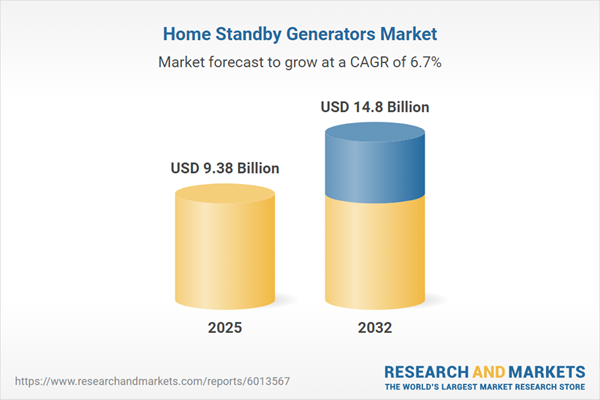Speak directly to the analyst to clarify any post sales queries you may have.
As operational risks and energy reliability challenges intensify, the home standby generators market has moved to the forefront of strategic planning for senior leaders focused on ensuring business continuity. Organizations now view standby power as essential for navigating infrastructure vulnerabilities and staying ahead of regulatory and industry demands.
Market Snapshot: Home Standby Generators Market Growth Trends
The home standby generators market is undergoing rapid growth, driven by increased awareness of power supply instability and the rising need for uninterrupted operations in both commercial and residential settings. This expansion is fueled by consistent investments in backup power and ongoing upgrades to generator technologies. Innovations such as enhanced digital controls and advanced safety features play a significant role in enabling reliability and operational flexibility.
Stakeholders are prioritizing the modernization of energy infrastructure and refining procurement practices. These adaptations ensure that organizations can quickly access and deploy backup systems tailored to their evolving operational environments and compliance requirements. Regulatory evolution and new risk management frameworks further support this trajectory, positioning home standby generators as integral to future-ready business strategies.Scope & Segmentation of the Home Standby Generators Market
This market analysis delivers comprehensive segmentation—supporting strategic decision-making and targeted investment in backup power solutions for organizations facing varied operational risks:
- End Users: Commercial, industrial, and residential organizations select generator models suited to maintaining essential functions and minimizing downtime during outages.
- Fuel Types: Options include bi-fuel, diesel, liquid propane, and natural gas, allowing flexibility in energy sourcing, performance outcomes, and alignment with sustainability and emissions strategies.
- Phase Types: Single-phase and three-phase generators suit a range of voltage and load demands, supporting installations across private dwellings and large-scale business sites.
- Power Ratings: Generator configurations span under 20 kW models for residential needs, mid-range units between 20–50 kW for small to midsize businesses, and systems exceeding 50 kW for advanced infrastructure resilience.
- Distribution Channels: Companies can access products via independent and franchise dealerships, direct procurement channels, and online platforms, improving logistics and streamlining purchasing processes.
- Regions: Market analysis covers the Americas, Europe, Middle East and Africa, and Asia-Pacific, highlighting how local regulations and adoption pace influence generator selection and deployment strategies.
- Represented Countries: The assessment includes major economies such as the United States, Canada, Brazil, Germany, China, and India, among a broader international sample, guiding region-specific planning and benchmarking.
- Key Companies: Leading manufacturers—Generac Power Systems, Briggs & Stratton, Kohler, Cummins, Caterpillar, and Hyundai Heavy Industries—stand out for their ongoing integration of technology and customized market approaches.
This detailed segmentation empowers leaders to calibrate procurement, mitigate risks tied to specific geographies or regulations, and ensure choices reflect both sustainability commitments and compliance needs.
Key Takeaways for Senior Decision-Makers
- Advanced diagnostic and remote monitoring technologies enable proactive maintenance, significantly reducing the risk of unplanned downtime and strengthening generator dependability in critical applications.
- Noise and emissions standards are shaping equipment selection, with heightened compliance requirements in urban and regulated regions prompting stricter evaluation during procurement and installation.
- Digital controls and support for multiple fuel types enhance adaptability and compatibility with developed and emerging energy management strategies.
- Comprehensive distributor and logistics frameworks provide reliable access to backup solutions across varied markets and infrastructure profiles.
- Collaboration with technology providers and the deployment of data analytics tools support advanced risk modeling, enabling customized procurement and continuous compliance management.
Tariff Impact: Addressing Supply Chain and Trade Shifts
Tariffs affecting generator components have prompted many organizations to reevaluate sourcing and production strategies. Suppliers are enhancing local manufacturing capabilities and tightening supply chain oversight to control costs and avoid disruptions. Alternative business models, such as leasing, power-as-a-service arrangements, and increased partnership activity, are fostering greater supply chain resilience and compliance with evolving trade standards.
Methodology & Data Sources
This research is based on a robust mixed-methods approach, blending thorough secondary market analysis with targeted interviews of experts in manufacturing and technology. These methods ensure actionable insights tailored to the priorities and decision frameworks of senior leaders navigating complex operational contexts.
Why This Report Matters
- Delivers insights that empower leaders to leverage advancing technologies, changes in infrastructure, and new regulatory demands in the backup power market.
- Provides tools to inform competitive strategies and investment decisions using frameworks that integrate global and regional benchmarks.
- Supports enhanced compliance, risk mitigation, and operational resilience across commercial and industrial sectors.
Conclusion
With targeted insights on technologies, regulations, and procurement, senior executives can proactively refine backup power strategies—maintaining business resilience and operational continuity in shifting environments.
Additional Product Information:
- Purchase of this report includes 1 year online access with quarterly updates.
- This report can be updated on request. Please contact our Customer Experience team using the Ask a Question widget on our website.
Table of Contents
3. Executive Summary
4. Market Overview
7. Cumulative Impact of Artificial Intelligence 2025
Companies Mentioned
The companies profiled in this Home Standby Generators market report include:- Generac Power Systems, Inc.
- Briggs & Stratton LLC
- Kohler Co.
- Cummins Inc.
- Caterpillar Inc.
- Hyundai Heavy Industries Co., Ltd.
- Yanmar Co., Ltd.
- Rolls-Royce Power Systems AG
- Denyo Co., Ltd.
- Atlas Copco AB
Table Information
| Report Attribute | Details |
|---|---|
| No. of Pages | 180 |
| Published | October 2025 |
| Forecast Period | 2025 - 2032 |
| Estimated Market Value ( USD | $ 9.38 Billion |
| Forecasted Market Value ( USD | $ 14.8 Billion |
| Compound Annual Growth Rate | 6.7% |
| Regions Covered | Global |
| No. of Companies Mentioned | 11 |









